On a mission to restore the Louisiana bayou
Loading...
The first time we waded out through the soft, yielding mud of the new marsh platform, Charlie, a dedicated landlubber, shot me a glance. "Just what have you gotten us into?" Two days earlier we'd been comfortably at home on the firm, dry ground of the landlocked Midwest. Now we were dragging burlap sacks of seedlings through murky waters amid crabs, shrimp, and, we were told, the occasional small alligator.
We'd decided to answer a call from the Louisiana coast for able-bodied adults to help restore some of the marsh lost to hurricane Katrina five years ago – volunteers who wouldn't mind getting down and dirty at an offshore mud flat, planting marsh hay on the beaches, and smooth marsh cordgrass out in the shallows. As retired dairy farmers we were no strangers to muck and could plant anything in our sleep. Having never seen the Louisiana bayou, and sharing a weakness for rail travel with Charlie, I signed us up.
We boarded Amtrak's "City of New Orleans" in central Illinois and rolled blissfully through the night and following morning to its southern terminus in The Big Easy. A day later we were motoring in airboats to the offshore site in the Big Branch National Wildlife Refuge directly north of New Orleans, across Lake Pontchartrain; then wallowing on the marsh-in-the-making while inserting root plugs to hold the mud in place and create new wildlife habitat.
The new platform was constructed in 2008 (with sediments dredged from the lake floor to keep shipping channels open) in a major private/public initiative, supported and coordinated by the Coalition to Restore Coastal Louisiana, The Lang Foundation, and the US Fish and Wildlife Service, among others. Since then, tens of thousands of plants have been individually inserted by hand on the berms, beaches, and out in the wet by hundreds of volunteers. Our own group represented Louisiana as well as New Hampshire, California, New Mexico, Massachusetts, and the Midwest. Many of us alighting from the airboats after a brief ride through the bayou looked at the semisubmerged acreage in faintly squeamish awe.
The place was alien to us, supremely muddy and stunning. Last year's plantings, which had taken hold and spread along root sprouts, stood in verdant clumps and islands in the rippling water. Egrets, pelicans, kites, and sandpipers filled the air and shorelines. Occasionally a small marsh bird disappeared with a sprout into a grassy nest. A few monarch butterflies seemed to be lingering on the sunbaked beach for one final rest before pushing across the Gulf of Mexico.
I had an uncharitable desire to commandeer a lawn chair and simply gaze out toward the horizon in dry and relatively clean comfort. What had I gotten us into?
As we waded out from the beach, dragging our own bags of smooth cordgrass behind us, I shared Charlie's initial reluctance to enter the murky unknown. We could not see the bottom and moved over it clumsily with our bare feet. For the first few minutes of acclimatization we used our dibbles – short metal rods with shovel-like flanges – to steady us. Then, pacing ourselves from others already at work, we began to cultivate the yielding bottom mud at five-foot intervals, dibbling holes and inserting plant plugs by hand into the ooze.
Before long, we were strangely at home, lulled by the birdcalls, sun, wavelets, and sight of the marsh platform greening in our wake. A familiar memory welled up of milking the cows in a similar state of mucky serenity. In fact, Charlie and I are naturals at this kind of steady physical work, however far from home.
Over our three-day volunteer vacation we restored not only a modicum of marshland, but also, we realized, something wounded in our own psyches by the hurricane, recent Gulf oil spill, and steady encroachment of lawn and asphalt over natural spaces.
This came home to us as we sat on a dry berm for a break on our last day, following the lazy dance of dragonflies over the water. Two of the winged creatures began to flutter synchronously right before our eyes. Finally they lighted on a stalk of cordgrass Charlie had just planted, and, finding the new perch to their liking, rested with us under the hot noon sun.





